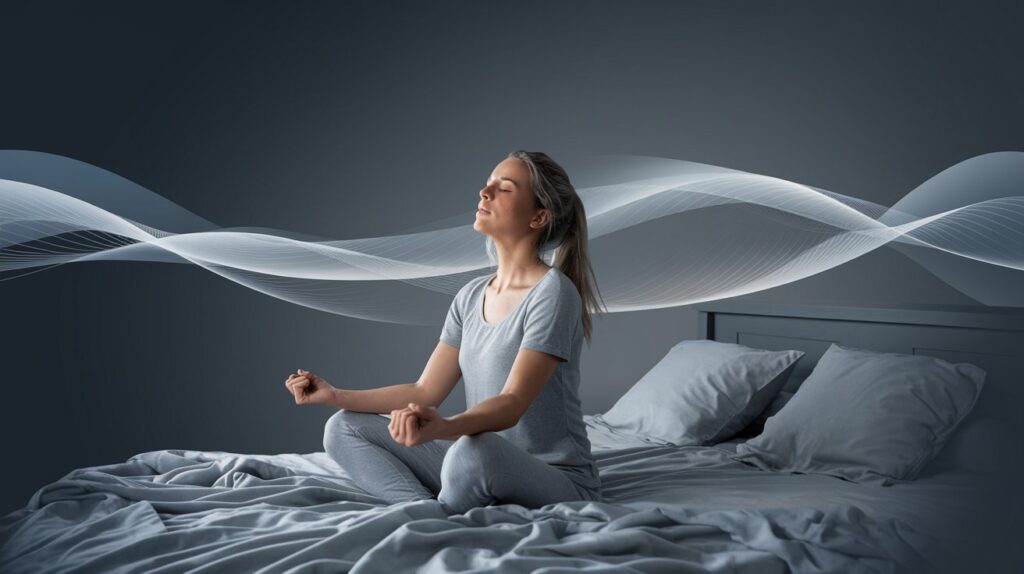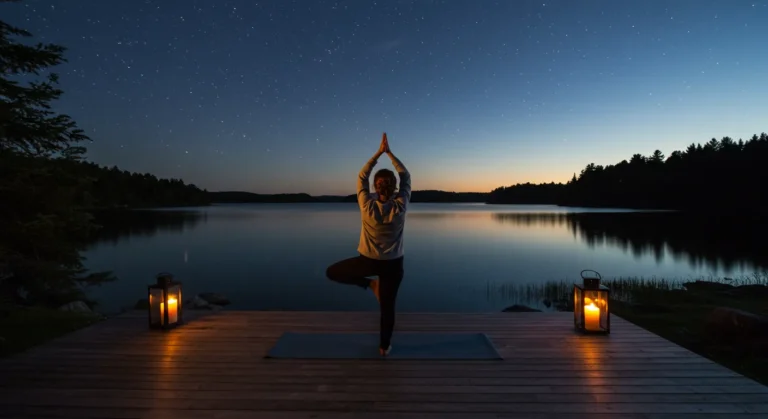10 Relaxation Exercises for Sleep to Do in Less Than 5 Minutes

It’s 2:47 AM. You’re staring at the ceiling, mind racing with tomorrow’s to-do list, that awkward conversation from three weeks ago, and why you can’t remember if you locked the front door. Your body is exhausted, but your brain? It’s throwing a full-scale party.
We’ve all been trapped in this frustrating cycle. You desperately want to sleep, but the harder you try, the more elusive it becomes. Here’s what most people don’t realize: forcing sleep is like trying to catch a butterfly with a net – the more aggressive you get, the further it flies away.
The secret isn’t in chasing sleep. It’s in creating the perfect conditions for it to find you naturally. Through targeted relaxation exercises for sleep, you can train your body and mind to transition smoothly from wakefulness to deep, restorative rest.
In this guide, you’ll discover science-backed breathing exercises for sleep anxiety, mental techniques that quiet racing thoughts, and bedtime rituals that signal your body it’s time to unwind. No more counting sheep – just proven methods that actually work.
Key Takeaways
- Relaxation exercises activate your parasympathetic nervous system for natural sleep
- Breathing techniques can reduce sleep anxiety by up to 65% in just 10 minutes
- Consistent bedtime rituals improve sleep quality more than sleep supplements
- Progressive muscle relaxation works faster than traditional meditation for beginners
- Mental exercises for sleep should focus on releasing rather than engaging thoughts
Why Your Brain Won’t Let You Sleep
Before diving into solutions, let’s understand the problem. Your brain has two main operating systems: the sympathetic (fight-or-flight) and parasympathetic (rest-and-digest) nervous systems.
When you can’t fall asleep, your sympathetic system is stuck in overdrive. It’s like having a car engine revving while you’re trying to park. The relaxation exercises we’ll explore act as your brake pedal, gradually downshifting your nervous system into sleep mode.
Common Sleep Disruptors:
- Stress hormones (cortisol, adrenaline)
- Blue light exposure affecting circadian rhythm
- Caffeine remaining in your system
- Racing thoughts and anxiety
- Physical tension from the day
The good news? Each of these has a specific relaxation exercise that can help neutralize its effects.
The Science Behind Relaxation and Sleep
Research from Stanford University shows that relaxation techniques can improve sleep quality by 42% and reduce the time it takes to fall asleep by an average of 37 minutes.
When you practice relaxation exercises for sleep, several physiological changes occur:
- Heart rate decreases by 10-15 beats per minute
- Blood pressure drops as blood vessels relax
- Breathing slows from 15-20 breaths to 6-8 per minute
- Muscle tension releases throughout your body
- Stress hormones decrease while sleep-promoting hormones increase
These changes don’t happen instantly – they’re like dimming lights gradually rather than flipping a switch.
10 Powerful Relaxation Exercises for Sleep
1. The 4-7-8 Breathing Technique
This breathing exercise for sleep anxiety is incredibly effective because it triggers your body’s relaxation response.
How to do it:
- Inhale through your nose for 4 counts
- Hold your breath for 7 counts
- Exhale through your mouth for 8 counts
- Repeat 4-6 cycles
Dr. Andrew Weil, who popularized this technique, calls it a “natural tranquilizer for the nervous system.” Many people fall asleep before completing the fourth cycle.
2. Progressive Muscle Relaxation (PMR)
This technique systematically releases physical tension that keeps you awake.
The Process:
- Start with your toes – tense for 5 seconds, then release
- Move to your calves – tense and release
- Continue up through thighs, glutes, abdomen, hands, arms, shoulders, neck, and face
- Focus on the contrast between tension and relaxation
PMR is particularly effective if you carry stress in your body or have trouble identifying where you’re holding tension.
3. The Mental Body Scan
This mental exercise for sleep helps quiet an overactive mind by giving it a focused task.
Step-by-step:
- Lie comfortably in bed
- Close your eyes and take three deep breaths
- Mentally “scan” your body from head to toe
- Notice any areas of tension without trying to change them
- Imagine breathing into tense areas and releasing on the exhale
This technique works because it redirects your attention from racing thoughts to physical sensations.
4. Visualization for Sleep
Create a mental sanctuary that your mind can escape to.
Popular Visualization Themes:
- Beach scene: Feel warm sand, hear gentle waves, smell salt air
- Forest walk: Imagine soft earth under your feet, dappled sunlight, bird songs
- Cozy cabin: Picture a warm fireplace, soft blankets, the sound of rain
The key is engaging all your senses to make the visualization as vivid as possible.
5. The 5-4-3-2-1 Grounding Technique
This exercise grounds you in the present moment, stopping anxious thoughts about tomorrow.
Identify:
- 5 things you can see (even with eyes closed – the back of your eyelids, shadows)
- 4 things you can touch (pillow, sheets, mattress, air temperature)
- 3 things you can hear (fan, traffic, your heartbeat)
- 2 things you can smell (detergent, room freshener)
- 1 thing you can taste (toothpaste, gum)
6. Alternate Nostril Breathing
This ancient yogic practice balances your nervous system.
Technique:
- Use your right thumb to close your right nostril
- Inhale through your left nostril for 4 counts
- Close left nostril with ring finger, release thumb
- Exhale through right nostril for 4 counts
- Inhale right, switch, exhale left
- Continue for 5-10 cycles
7. The Worry Window Technique
If racing thoughts keep you awake, this mental exercise creates boundaries around worry time.
How it works:
- Acknowledge the worry: “I notice I’m thinking about tomorrow’s presentation”
- Set a boundary: “I’ll think about this during my worry window tomorrow at 3 PM”
- Redirect: “Right now is sleep time, not worry time”
- Return to breathing or another relaxation technique
8. Mindful Counting
This gives your mind something neutral to focus on instead of stressful thoughts.
Variations:
- Count backwards from 100 by 7s
- Count your breaths from 1 to 10, then start over
- Visualize each number in a different color
When your mind wanders (it will), gently return to counting without judgment.
9. Loving-Kindness Meditation for Sleep
This practice releases the day’s tensions and promotes feelings of peace.
The Practice:
- Start with yourself: “May I be peaceful, may I be at rest”
- Extend to loved ones: “May my family be peaceful, may they be at rest”
- Include neutral people: “May my coworkers be peaceful”
- Even difficult people: “May those who challenge me find peace”
This technique works because it shifts your focus from stress to compassion.
10. The Cognitive Shuffle
Developed by sleep researcher Dr. Luc Beaudoin, this technique occupies your mind with boring, random thoughts.
How to do it:
- Pick a random word (like “bedtime”)
- For each letter, think of items that start with that letter
- B: banana, butterfly, bridge, book…
- E: elephant, envelope, elbow…
- Continue until you fall asleep
The randomness prevents your mind from creating meaningful connections that could keep you awake.
Creating Your Personal Sleep Ritual
| Time Before Bed | Activity | Duration | Purpose |
| 60 minutes | Dim lights, no screens | Ongoing | Support circadian rhythm |
| 30 minutes | Warm bath or shower | 10-15 min | Lower body temperature |
| 20 minutes | Choose 2-3 relaxation exercises | 15-20 min | Activate relaxation response |
| 5 minutes | Final breathing exercise | 5 min | Transition to sleep |
Consistency is key – your body learns to anticipate sleep when you follow the same routine nightly.
Optimizing Your Sleep Environment
Your bedroom should be a sanctuary for rest. Consider these factors:
Temperature: Keep it cool (65-68°F). Your body naturally drops temperature to initiate sleep.
Darkness: Use blackout curtains or an eye mask. Even small amounts of light can disrupt your circadian rhythm.
Sound: White noise machines or earplugs can mask disruptive sounds.
Comfort: Invest in a quality mattress and pillows that support your sleep position.
Technology: Keep phones and tablets out of reach. The blue light interferes with melatonin production.
Common Mistakes to Avoid
Trying too hard: The more you force sleep, the more elusive it becomes. Relaxation exercises should feel effortless.
Inconsistent practice: Doing these exercises only when you can’t sleep is like trying to learn piano only during concerts. Practice when you’re not stressed too.
Giving up too quickly: Some techniques take 2-3 weeks of consistent practice to show full benefits.
Checking the clock: This creates anxiety about lost sleep time. Turn clocks away from your bed.
Caffeine after 2 PM: It can stay in your system for 6-8 hours, interfering with sleep even if you don’t feel wired.
When to Seek Professional Help
While relaxation exercises work for most people, sometimes underlying issues need attention:
- Persistent insomnia lasting more than 3 weeks
- Loud snoring or breathing interruptions (possible sleep apnea)
- Restless legs or frequent movement during sleep
- Excessive daytime fatigue despite adequate sleep time
- Mood changes related to poor sleep
A sleep specialist can identify and treat conditions that relaxation exercises alone can’t address.
Building Long-Term Sleep Success
Think of good sleep as a skill you’re developing, not a problem you’re solving. Like learning any new skill, it requires patience and practice.
Track your progress with a simple sleep diary. Note which exercises work best for you and how your sleep quality improves over time.
Be patient with yourself. Some nights will be better than others. Focus on the overall trend rather than individual nights.
Experiment with combinations. You might find that breathing exercises work better on stressful days while visualization helps more on mentally busy nights.
The goal isn’t perfect sleep every night – it’s developing a toolkit of techniques that help you sleep better most nights. With consistent practice, these relaxation exercises for sleep will become second nature, helping you drift off peacefully instead of wrestling with insomnia.
Remember, quality sleep isn’t a luxury – it’s essential for your physical health, mental clarity, and emotional well-being. Every night you practice these techniques is an investment in a more energized, focused, and balanced tomorrow.
Sweet dreams start with the simple decision to prioritize your rest. Choose one technique tonight and begin your journey toward better sleep.
Ready to transform your nights? Explore our complete guide to optimizing your circadian rhythm and building the perfect bedtime routine for sustained energy and focus.
Disclaimer: The information provided is for educational purposes only, not a substitute for professional medical advice. Always consult a healthcare professional.







